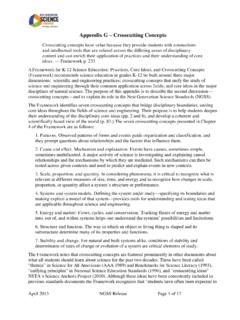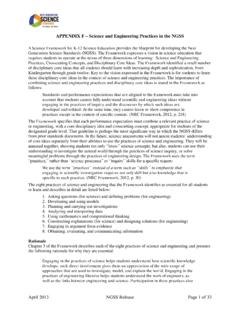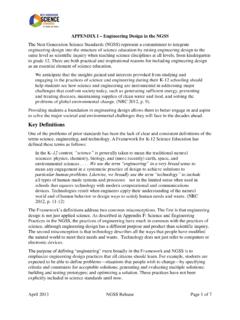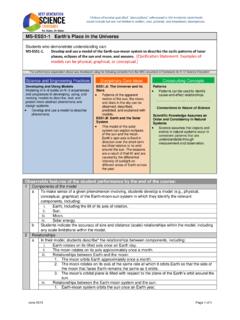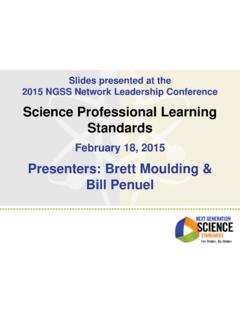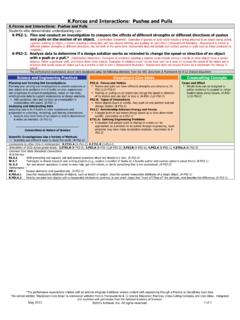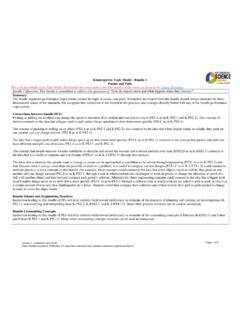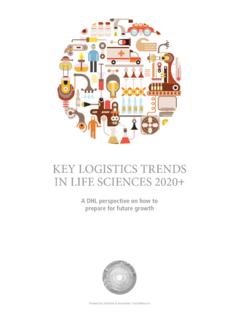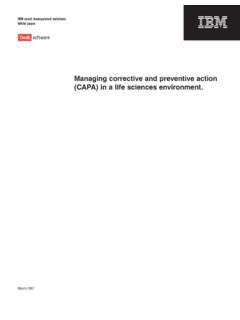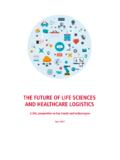Transcription of High School Earth and Space Sciences - …
1 High School Earth and Space Sciences Students in high School continue to develop their understanding of the three disciplinary core ideas in the Earth and Space Sciences . The high School performance expectations in Earth and Space Science build on the middle School ideas and skills and allow high School students to explain more in-depth phenomena central not only to the Earth and Space Sciences , but to life and physical Sciences as well. These performance expectations blend the core ideas with scientific and engineering practices and crosscutting concepts to support students in developing useable knowledge to explain ideas across the science disciplines.
2 While the performance expectations shown in high School Earth and Space science couple particular practices with specific disciplinary core ideas, instructional decisions should include use of many practices that lead to the performance expectations. The performance expectations in ESS1: Earth s Place in the Universe, help students formulate an answer to the question: What is the universe, and what is Earth s place in it? The ESS1 Disciplinary Core Idea from the NRC Framework is broken down into three sub-ideas: the universe and its stars, Earth and the solar system and the history of planet Earth .
3 Students examine the processes governing the formation, evolution, and workings of the solar system and universe. Some concepts studied are fundamental to science, such as understanding how the matter of our world formed during the Big Bang and within the cores of stars. Others concepts are practical, such as understanding how short-term changes in the behavior of our sun directly affect humans. Engineering and technology play a large role here in obtaining and analyzing the data that support the theories of the formation of the solar system and universe. The crosscutting concepts of patterns, scale, proportion, and quantity, energy and matter, and stability and change are called out as organizing concepts for these disciplinary core ideas.
4 In the ESS1 performance expectations, students are expected to demonstrate proficiency in developing and using models, using mathematical and computational thinking, constructing explanations and designing solutions, engaging in argument, and obtaining, evaluating and communicating information; and to use these practices to demonstrate understanding of the core ideas. The performance expectations in ESS2: Earth s Systems, help students formulate an answer to the question: How and why is Earth constantly changing? The ESS2 Disciplinary Core Idea from the NRC Framework is broken down into five sub-ideas: Earth materials and systems, plate tectonics and large-scale system interactions, the roles of water in Earth s surface processes, weather and climate, and biogeology.
5 For the purpose of the NGSS, biogeology has been addressed within the life science standards. Students develop models and explanations for the ways that feedbacks between different Earth systems control the appearance of Earth s surface. Central to this is the tension between internal systems, which are largely responsible for creating land at Earth s surface, and the sun-driven surface systems that tear down the land through weathering and erosion. Students begin to examine the ways that human activities cause feedbacks that create changes to other systems. Students understand the system interactions that control weather and climate, with a major emphasis on the mechanisms and implications of climate change.
6 Students model the flow of energy between different components of the weather system and how this affects chemical cycles such as the carbon cycle. The crosscutting concepts of cause and effect, energy and matter, structure and function and stability and change are called out as organizing concepts for these disciplinary core ideas. In the ESS2 performance expectations, students are expected to demonstrate proficiency in June 2013 2013 Achieve, Inc. All rights reserved. 1 of 8 developing and using models, planning and carrying out investigations, analyzing and interpreting data, and engaging in argument; and to use these practices to demonstrate understanding of the core ideas.
7 The performance expectations in ESS3: Earth and Human Activity help students formulate an answer to the question: How do Earth s surface processes and human activities affect each other? The ESS3 Disciplinary Core Idea from the NRC Framework is broken down into four sub-ideas: natural resources, natural hazards, human impact on Earth systems, and global climate change. Students understand the complex and significant interdependencies between humans and the rest of Earth s systems through the impacts of natural hazards, our dependencies on natural resources, and the significant environmental impacts of human activities.
8 Engineering and technology figure prominently here, as students use mathematical thinking and the analysis of geoscience data to examine and construct solutions to the many challenges facing long-term human sustainability on Earth . The crosscutting concepts of cause and effect, systems and system models, and stability and change are called out as organizing concepts for these disciplinary core ideas. In the ESS3 performance expectations, students are expected to demonstrate proficiency in developing and using analyzing and interpreting data, mathematical and computational thinking, constructing explanations and designing solutions and engaging in argument; and to use these practices to demonstrate understanding of the core ideas.
9 June 2013 2013 Achieve, Inc. All rights reserved. 2 of 8HS-ESS1 Earth s Place in the Universe * The performance expectations marked w ith an asterisk integrate traditional science content w ith engineering through a P ractice or D isciplinary C ore Idea. The section entitled Disciplinary Core Ideas is reproduced verbatim from A Framework for K-12 S cience E ducation: P ractices, C ross-C utting C oncepts, and C ore Ideas. Integrated and reprinted w ith permission from the N ational A cademy of S ciences. HS-ESS1 Earth s Place in the Universe Students who demonstrate understanding can: HS-ESS1-1.
10 Develop a model based on evidence to illustrate the life span of the sun and the role of nuclear fusion in the sun s core to release energy that eventually reaches Earth in the form of radiation. [C larification S tatement: E mphasis is on the energy transfer mechanisms that allow energy from nuclear fusion in the sun s core to reach Earth . Examples of evidence for the model include observations of the masses and lifetimes of other stars, as well as the ways that the sun s radiation v aries due to sudden solar flares ( Space w eather ), the 11-y ear sunspot cy cle, and non-cy clic v ariations ov er centuries.]

